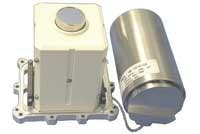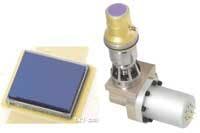Infrared detectors have been widely used in the military since the 1970s with the so-called first-generation IR cameras that used cooled, relatively small linear arrays of photodetectors with a complex two-dimensional (2-D) scanning system. The second generation of IR detectors was demonstrated at the research level in the early 1980s and produced for sale in the early 1990s. This second generation was defined by the use of IR-sensitive photodetectors coupled with a readout integrated circuit (ROIC) for signal preprocessing and multiplexing on the focal plane, including an analog multiplexer (see Fig. 1).
With this second-generation structure, the number of pixels on the focal plane was, in principle, no longer limited, the scanning system was simplified, and the performance was improved. As for the sensitivity of these new IR focal-plane arrays, the second-generation detectors were primarily based on cooled photovoltaic diodes to reduce electrical power dissipation per pixel. The material chosen for the sensitive array was mainly HgCdTe (mercury cadmium telluride).
In addition to spatial resolution, thermal resolution of IR detectors is of major interest to system manufacturers because the thermal sensitivity of the detector affects the definition of the host system (optical configuration and signal processing) and its performance (detection range and detection sensitivity, for example).
The main function of a detector is to sense IR radiation coming from a scene and to deliver an electrical signal proportional to the radiation. The performance of a detector is therefore determined by its ability to extract a small target from an IR background when the temperature of the target is close to the background temperature. For second-generation systems, the serial-scanning system limits the integration time, and thus the only way to increase thermal sensitivity is to maximize the signal level as well as the IR contrast. This is possible in the long-wavelength region where there is more IR flux emitted, and is the principal reason why second-generation scanning systems have been widely used in the region from about 8 to 10.5 µm.
Improving IR detectors
The transition from first- to second-generation IR detectors opened the way for high-resolution scanned arrays with time delay and integration (TDI), as well as high-resolution 2-D arrays and signal processing on the focal plane. For the long-wavelength range, TDI linear arrays are close to the theoretical limit of spatial and thermal performance, including residual fixed-pattern noise behavior, and can offer the high-performance system needs of today’s military and industrial applications: ruggedness, tolerance to severe environmental conditions and high blooming levels, and optical countermeasures (measures taken in the optical system to counter potential blooming or degradation in the detected IR signal due to laser radiation).
Most of the second-generation forward-looking IR (FLIR) thermal cameras are based on the 288 × 4 detector.1 The highest-resolution second-generation IR detection system, the 480 × 4 or 480 × 6 CMOS IR focal-plane array, was chosen by the United States Army in the 1990s and is incorporated in the Standard Advanced Detector Assembly II (SADA II; see Fig. 2). It is based on a 480 × 6 integrated Dewar and cooler assembly (IDCA) concept with integrated cryogenic cooler using the Stirling thermodynamic cycle and integrated readout and drive electronics.Batch processes
Today, cooled medium-wavelength IR sensors offer higher resolution than long-wavelength IR sensors, thanks to the availability of large-array formats that lead to better target identification at long ranges. However, to meet most semiconductor-manufacturers’ requirement for decreased manufacturing costs, the size of the array needs to be reduced and the number of arrays per manufacturing wafer increased. To maintain resolution, it is necessary to decrease the pixel pitch of the sensors. Therefore, the goal of 2-D IR focal-plane-array development is to increase the staring-array detector format (to television format and larger) by decreasing the pixel pitch. But when the pixel pitch is decreased, it is necessary to increase the storage capacitance or at least to maintain an equivalent storage capacitance to keep a high performance level. In comparison with the visible region, the pitch size is diffraction-limited in the IR spectrum, with the number of pixels limited by the size of the focal-plane array.
The silicon-like HgCdTe implantation technique allows a simplified high-yield production process that makes it possible to produce smaller diodes and thus finer and less-expensive optics and cryogenic coolers than can be obtained using indium antimonide or other established processes. Based on the demonstrated advances in HgCdTe technology by French researchers, the development of small-pitch mid-wavelength 2-D arrays is possible.2 As an example, the Scorpio detector (see Fig. 4) consists of a 640 × 512 mid-wavelength array with 15-µm pixel pitch and is the same size as existing medium-resolution 320 × 256 mid-wavelength IR detectors with a 30-µm pixel pitch, enabling a TV-format detector with the same optical field. It can therefore be used as a drop-in replacement with four times the number of pixels, a low power requirement, and increased reliability. These mass-production formats in the medium-wavelength region are between 80,000 and 320,000 pixels, and are being used in medium- to high-performance applications including missiles, enhanced vision, thermal sights, and industrial applications.For very long detection and identification ranges, it is necessary to increase the resolution of the detector. For example, IR search and track systems and long-range reconnaissance systems need very large mid-wavelength formats compatible with slow optics. To meet these needs, HgCdTe megapixel (1000 × 1000) IR focal-plane arrays detecting in the 3- to 5-µm wavelength range and with a very small pixel pitch of 15 µm were demonstrated at the Infrared Laboratory of the Commissariat d’Energie Atomique (CEA-LETI/LIR; Grenoble, France) in 2002.3 In the United States, a format as large as 2000 × 2000 detecting in the 3- to 5-µm waveband has been demonstrated.4
For the longer wavelengths, the growing market for staring arrays and overall demands for newer, cheaper, and smaller systems, have pushed toward the development of long-wavelength IR staring arrays either for future upgrades of TDI long-wavelength linear arrays or for new systems for hyperspectral applications for manufacturing control and for space instruments.
Long-wavelength HgCdTe arrays are available with different wavebands: bandpass detection (8-9, 8-10.5, 8-11 µm, or larger, on a case-by-case basis) for imaging applications, or wide-spectrum detection (1-9.5 and 1-12 µm) for specific applications like spectrometry or astronomy.
However, for imagery applications, the small-bandpass 8- to 9-µm spectral bandwidth is sufficient for obtaining high-performance thermal cameras when long integration times are allowed. Then, quantum-well IR photodetectors (QWIPs) are available for large-format long-wavelength IR thermal cameras.
Beyond military applications
While IR detectors are a key issue for many high-performance military and space applications, they are also being used in more and more commercial applications. For commercial applications in which performance is not the limiting factor, uncooled detector technologies have been offered since the beginning of 2000 and are addressing new application types with large volumes based on their low production cost. These new uncooled IR arrays are based on thermal detection using bolometer thermometers. Their resolution capabilities have steadily improved and are up to 300,000 pixels. They are addressing detection ranges from a few tenths of a meter up to about 1000 meters and more. These differences in cooled IR camera performance will diminish in the coming years and the resolution of IR detectors will probably increase, given the history of rapid visible-array development.
One promising application for these uncooled IR systems is in the automotive industry. One method of improving driving safety is to use IR cameras for better visibility at night or through fog and to avoid obstacles. Transition of IR detection technology from military applications to commercial automotive applications will most likely reduce the price of these detectors, opening a pathway to large-scale use of IR detectors in our daily lives.
REFERENCES
1. P. Tribolet et al., Proc. SPIE 4130, 422 (December, 2000).
2. P. Tribolet et al., Proc. SPIE 5406, 193 (August, 2004).
3. P. Castelein et al., Proc. SPIE 5074, 52 (October, 2003).
4. R. Rawe et al., Proc. SPIE 5406, 152 (August, 2004).



